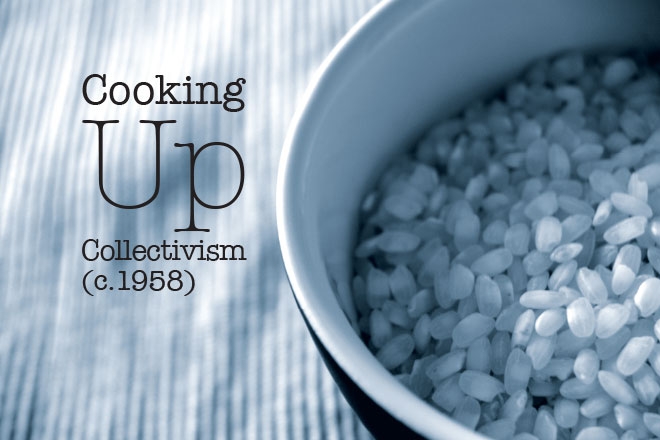There’s no such thing as a free lunch. But not in China. Once upon a time in Chinese history, there was not only free lunch but also free meals everyday, for everyone.
The People’s Commune was the highest of three administrative levels in rural areas of the People’s Republic of China during the period from 1958 to 1983, after which they were replaced by townships. Communes, the largest collective units, were divided in turn into production brigades and production teams. It was the result of the “Great Leap Forward” movement aiming to rapidly transform the country into a socialist society through rapid industrialisation and collectivism. Mao Zedong had a vision of surpassing Great Britain and the United States in steel production in 15 years. As an approach to “free work force and ease to communism”, the “People’s Commune dining hall” system was introduced.
Private kitchens became redundant, and everything in personal kitchens, such as tables, chairs, cooking utensils and pans (even the proverbial kitch sink) were all contributed to the commune’s kitchen. Private cooking was banned and replaced by communal dining. Everything originally owned by the households; animals, stored grains and other food items were also contributed to the commune. All farming activities were to be centrally assigned by cadres every morning. Everybody in the commune was assigned jobs by their commune leaders.
In some places, even money was outlawed.
“Loosen your belt and eat all you can” was a popular slogan around that time. Imagine you were living in the Chinese countryside in 1958. You bring your bowl and chopsticks to the dining hall, where it offers an all-you-can-eat buffet style meal served in big porcelain basins. For staples, the usual is porridge for breakfast; rice cake for lunch and steamed rice and yam for supper. The regulations for commune kitchens state clearly that each commune has to serve meat at least twice a month and try to change menus as often as possible.
If you were lucky, you might have fellow comrades bringing your food to the table, almost like dining in a restaurant. The only differences are that you eat with the whole village and when you are done, you can just walk away with your bowl and chopsticks without having to pay a single penny.
“It’s our rule not to take meal ticket or money from anyone. We are one step away from Communism. This is how it should be”, a former cadre wrote in his later published diary on the dinning hall system.
In October 1958, more than three million People’s commune dining halls had sprung all over the country. 90 percent of the countryside population was dependent on the commune kitchen. It has been documented that in a small village in Hebei province, 2,889 people were grinding rice everyday in order to meet the demanding needs.
However in 1959, most dining halls could not be sustained any longer. On account of governmental control over rural resources and bad weather that year, famine became widespread throughout the countryside, with many food resources being exported to urban areas. The commune kitchen started to limit portions for everyone in the form of meal tickets given to each household every month.
It was to become worse in 1960 when every household could only have 250 grams of rice per day. Then, as a solution to food shortages ,the government urged the farmers to go out in the wild and gather whatever they could eat, such as plant seeds and leaves. In a small town of Hebei province, 590 villagers harvested 458,000 kilograms of leaves and herbs in a week.
Finally in 1961, thanks to Deng Xiaoping’s investigation in the countryside and letters to Beijing, the central government released a written document allowing the commune members to decide whether they want the dining hall system or not. So after three years of free meals for all, the public dining hall system came to an end as a result of farmers’ consent.
Nowadays, some restaurants capitalise on nostalgia for the period. One chain restaurant in Nanjing, the “Jiangnan People’s Dining Hall”, serves spicy cuisine from Mao’s hometown in Hunan. Surrounded by decorations on red brick walls carrying fervent slogans while watching waitresses in 60s-style atire bring out dishes the size of basins, one might have a faint feeling of stepping back into the old red China. However, upon asking for the bill, you will be pulled back to reality that China is on its highway towards commercialism with no intention of turning back.









